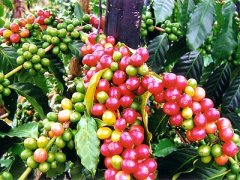Processing of boutique coffee beans processing of Costa Rican coffee
Costa Rica's production is small, with an annual output of about 110000 tons, ranking seventh in Central and South America. Costa Rica is dominated by new varieties of coffee, such as Kaddura, Kaduai, New World and so on, while the ancient bourbon and Tibica are rare. There are also many varieties in the territory, the most famous is the bourbon variety Yala Saatchi, a variety of elegant flavor, Brazil has also been introduced and planted, has won a prize.

In addition, Costa Rican research institutions have spared no effort to improve the mixed-race Katimo, trying to reduce the stout bean pedigree and enhance the Arabica flavor of Katimo, which has been exported to Asia for trial cultivation in recent years.
Costa Rica mostly uses water washing treatment, and in recent years there has also been an alternative half-sun treatment, 'Miel', or' Honey Coffee', which can be translated as "sweet as honey", which competes with Brazilian half-sun treatment. The coffee produced in Colombia is as sweet as honey, all of which are marked with a big 'Honey Coffee',' on the sacks. It improves the Brazilian half-sun method to increase sweetness, focusing on keeping the pectin layer sticking to the pods as completely as possible (in Brazilian style, scraping off part of the gum layer), peeling and moving the pods to an outdoor viaduct, similar to the practice in Kenya. to avoid absorbing the odor and moisture of the land (Brazil is placed on cement), and then exposed to the sun and air-dried for about one to two weeks (half-sun in Brazil is only exposed for one to three days. Supplemented by machine drying Costa Rica's "as sweet as honey" is dried in the sun. During this period, the pods have to be turned every hour to evenly dry, so that the beans can fully absorb the fruit aroma and sugar essence of the thick pectin layer, and after dehydration, they have to be placed in a wooden container, which is extremely labor-intensive, but the fruit of the "honey brew" tastes as sweet as honey. The disadvantage is that the risk of this method is very high, and it is easy to mildew and rot when the weather is too wet.
Costa Rica is not drier than Brazil, but it dares to use long-term exposure, which makes people pinch a cold sweat, but it also reflects Costa Rican coffee craftsmanship.
Important Notice :
前街咖啡 FrontStreet Coffee has moved to new addredd:
FrontStreet Coffee Address: 315,Donghua East Road,GuangZhou
Tel:020 38364473
- Prev

Colombian Gesa Coffee introduces Rosa Coffee Colombian Fine Coffee Colombian Coffee
Geisha is an Arabica coffee variety from Geisha Mountain in southwestern Ethiopia, which is transliterated as Gesha. Because the Japanese pronunciation of geisha is similar to Geisha, Geisha is called geisha coffee in Japan. I think it is easier to communicate with foreign countries by transliteration. According to the Panamanian Emerald Manor website, Gaixia Coffee Seeds began in 1931.
- Next

The origin of Jamaican coffee the elegant demeanor of Jamaican coffee the characteristics of Jamaican coffee
Almost everyone in Jamaica knows that Blue Mountain Coffee is the most expensive coffee in the world. In 1725, Sir SirNicholasLawes brought the first Blue Mountain Coffee species from Martinique to Jamaica and planted them in the St.Andrew area. Coffee producing area of Jamaica: today's St. Andrews is still Blue Mountain Coffee.
Related
- Detailed explanation of Jadeite planting Land in Panamanian Jadeite Manor introduction to the grading system of Jadeite competitive bidding, Red bid, Green bid and Rose Summer
- Story of Coffee planting in Brenka region of Costa Rica Stonehenge Manor anaerobic heavy honey treatment of flavor mouth
- What's on the barrel of Blue Mountain Coffee beans?
- Can American coffee also pull flowers? How to use hot American style to pull out a good-looking pattern?
- Can you make a cold extract with coffee beans? What is the right proportion for cold-extracted coffee formula?
- Indonesian PWN Gold Mandrine Coffee Origin Features Flavor How to Chong? Mandolin coffee is American.
- A brief introduction to the flavor characteristics of Brazilian yellow bourbon coffee beans
- What is the effect of different water quality on the flavor of cold-extracted coffee? What kind of water is best for brewing coffee?
- Why do you think of Rose Summer whenever you mention Panamanian coffee?
- Introduction to the characteristics of authentic blue mountain coffee bean producing areas? What is the CIB Coffee Authority in Jamaica?

